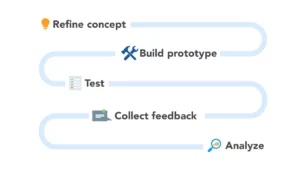Around 95% of new products fail. Let that sink in. This means that very few startups entering the market will actually make it. So, how can you increase your chances of success and avoid becoming another statistic?
The answer is simple: product validation.
Before pouring time and resources into building a software product, ensuring that your business idea resonates with your target audience is crucial.
In this article, we’ll explore the key benefits of product validation and provide actionable tips from our experts at MOHARA to help founders validate their ideas and beat the odds.
What Is Product Validation?
Product validation is the process of testing and verifying whether a product or service meets the needs and expectations of its target audience. This ensures that there is a market demand for the product and that it solves a real problem for its intended users.
The process of product validation typically involves collecting feedback from potential users through surveys, interviews, or product demos. This feedback is used to refine the product design and features, ensuring potential users get what they want and need.
Businesses can avoid costly mistakes by validating the product before launching it to the market, making it a crucial step for early-stage startups.
The Benefits of Product Validation
Successful products solve real problems for their target audience. That’s where product validation comes in – it helps founders to figure out if their product meets their customer’s needs and has a good chance of success in the market.
A process for validating ideas should be your top priority as a founder. By validating your product before launching it, you can minimize risks and maximize your chances of success. It also helps you drive innovation and foster long-term growth, as you can use feedback from your target audience to continually improve your product over time.
Below, we’ll explore the many benefits of the product validation process and why it’s important to validate new business ideas:
➡️Minimize costs: Through validation, founders can identify which product features potential customers want. By prioritizing these aspects and focusing development resources on them, startups can save time and money while maximizing product impact.
➡️Enhancing user experience: Gathering customer feedback during product validation allows founders to identify pain points and areas for improvement, leading to a better overall user experience.
➡️Streamlining product-market fit: Validation helps founders identify their target audience and understand customer needs. This enables startups to tailor their business model and marketing strategies to serve their target market best.
➡️Attracting investors: A validated product with a clear market demand can appeal more to investors, as it demonstrates the potential for growth and return on investment.
➡️Increasing credibility and trust: Showcasing that a product has gone through a validation process and has been positively received by prospective customers can increase the credibility of a startup, making it easier to build trust with potential stakeholders.
The Lean Product Validation Process
Validating product ideas is hugely beneficial, as it prevents you from spending too much on an idea that may not work.
One of the most common product validation methods is the lean process, of which the popular Build-Measure-Learn methodology forms a part.
The following sections outline the main components of lean validation:
Validate the problem
Before developing a solution, it is crucial to confirm that the problem your product aims to solve is genuine and relevant to your target audience. Conduct comprehensive market research, interview potential users, and gather insights to understand target users’ needs, pain points, and desires.
By validating the problem, you ensure that your product addresses a genuine need in the market.
Validate the market
The next step to validate your product is competitor research. While having a great idea is one thing, you may only want to take the idea further if the market is big enough.
You must gather as much information as possible on your direct competitors at this stage. Understanding the landscape will help you to determine the size of your market and the price you can charge for your product.
What happens if you don’t find any competitors? There are two possibilities:
1️⃣You have either missed something or you are trying to solve a problem that doesn’t exist. In that case, you might want to shelve this idea!
2️⃣The market may not exist yet. We understand your idea might be the next big thing, like Uber or Whole Foods. While we don’t want to kill your dreams, these companies are rare, so do your homework!
Here are a few ways to validate the market:
➡️Conduct deep competitor research to understand how your future competitors are trying to solve the same problem.
➡️Follow Google Trends to compare the relative volume of search terms over a 12-month period.
➡️Use theGoogle AdWords’ Keyword Planner to estimate the monthly search volume and traffic potential.
➡️Use Moz to provide insights into competitor ranking and content performance.
Validate the product
Once you have an idea that will solve a real problem, and you know there is a market for it, it is time to create a minimum viable product (MVP) and test it with real users.
Conduct user interviews and surveys to gather feedback on usability, functionality, and overall value. Use this information to iterate and refine your product, ensuring a strong product-market fit. Product validation helps you develop a solution that truly meets the needs of your target audience and maximizes its potential for success.
Validate profitability
Okay, so you’ve got a product that solves an actual problem. But here’s the real question: will they be willing to pay for it?
To ensure your product can generate sustainable profits, you must assess its revenue potential, cost structure, and pricing strategy. Consider how much it’ll cost to acquire customers, how long they will likely stick around, and how much it’ll cost to produce your product.
You’ll also want to look at what your competitors are charging and ensure your pricing is competitive.
Methods for Fast Validation
The lean product validation approach is widely used in software product design for quickly validating ideas.
However, at MOHARA, we use an alternative idea validation approach that has proven to be highly effective, and we’re excited to share it with you. So, let’s dive in and explore this approach in more detail!
With over 100 startup venture partners, we’ve seen many product validation processes! Based on our experience, the pre-pilot phase recipe developed by Who’s Fabio is one of the most effective approaches to idea validation.
This recipe offers a clear and structured framework for validating your product idea to ensure that you’re creating a product that meets the needs of your target audience and has the potential to succeed in the market.
At MOHARA, we’ve seen this recipe work repeatedly, helping founders validate their ideas and successfully bring their vision to life. The “recipe” for the product valuation formula is based on 3 gateways:
1️⃣Waiting list: A waiting list of people who are eager to use your product
2️⃣Master plan: A plan to turn your idea into a market-leading start-up
3️⃣Pilot: A working product pilot/MVP with robust user retention
We’ll discuss each of these gateways in more detail below:
1️⃣Build a waitlist to attract your target audience
To begin validating your product, start with creating a waitlist. A waitlist is a list of people who are interested in trying out your product before it’s officially launched. By building a waitlist, you’re showing that real people are experiencing a problem your product aims to solve and that they’re excited enough about your value proposition to want to try it out.
It also demonstrates market demand to potential investors. Having a healthy waitlist shows potential stakeholders there’s a real need for your product and that you can acquire market share amongst your target audience.
Startups can also use the waitlist to build buzz around their product, gather feedback from interested users, and create a sense of urgency that can help drive early sales once their product is launched.
How to build your waitlist
Value proposition
The first step you need to take to create your waitlist is to construct your SMS Pitch. An SMS pitch is a compelling, short message encapsulating your product’s value proposition. This message should highlight the problem you’re addressing, the solution you offer, and the unique benefits that set you apart from competitors.
Below we’ll discuss what needs to be included in your SMS pitch:
✅Who:
Clearly define the specific market segment or customer group your product or service is intended for. What are their common characteristics? Who would be your ideal super user?
✅Problem or need:
Part of your value proposition will show potential users that you understand their pain points to demonstrate the relevance of your offering.
To truly understand the problem, it’s important to talk to both people who are actively facing the problem and don’t know how to solve it (“strugglers”) and people who have taken the first steps towards solving the particular problem (“masters”).
Masters may be working manually or inefficiently, but they have valuable insights to inspire your product development. Alternatively, they may have identified limitations or areas where their current solution falls short, which can inform your approach to creating a better solution.
By evolving the solution for them, you can create a solution tailored to their specific needs and challenges and deliver meaningful value to them.
Ultimately, by leveraging the insights of both masters and strugglers, you can create a product that truly meets the needs of your target audience and delivers a compelling value proposition.
| 💡 Expert Insight:
“The idea of the ‘struggle’ originates from a fascinating theory developed during World War II. Analysts were tasked with studying damaged bombers to improve their resilience and reduce damage in the future. However, they discovered it was more useful to study the planes that didn’t make it back than the ones that did. So rather than patching up the surviving planes, engineers analyzed the damage on downed planes to identify the weaknesses in the plane’s design. These insights were used to strengthen the surviving planes.” The same principal goes for your value proposition. Don’t only talk to “masters,” i.e., the planes who made it back, but also speak to the strugglers! Richard Sams – Co-Founder and CEO at MOHARA |
✅Outcome:
Tell your potential customers how your product or service solves the identified problem or meets their needs and also what they can expect from your product.
✅Unique selling proposition (USP) or “secret sauce”:
You must differentiate your product or service to stand out by highlighting what sets it apart.
Your “secret sauce” combines features and benefits that turn a struggler into a master – someone who can get the job done faster, cheaper, and with optimal results.
Highlight no more than three features that show potential customers how your offering is superior to the competition.
⚠️Remember to keep your message simple and concise and avoid jargon.
Test and iterate the product pitch
When pitching your product, it’s important to do user testing to ensure that your message effectively communicates the value of your offering. One way to do this is to send your initial SMS pitch to a sample of your target audience and ask for their feedback.
Collect feedback and note any recurring themes, suggestions, or criticisms. This feedback can help you understand what aspects of your pitch resonate well and which ones require improvement.
Use the feedback to address any concerns, clarify confusing points, and emphasize the unique benefits of your product more effectively. By iterating on your pitch and incorporating feedback from your target audience, you can create a value proposition that resonates with potential users and addresses a genuine need or problem.
To ensure that you’ve successfully communicated the value of your product, aim to reach a 90% positive response rate from your target audience. This high success rate indicates that your message is effective and that your product is meeting a real need in the market.
Create a landing page
Create a visually appealing and easy-to-navigate landing page that incorporates your refined pitch and highlights your product’s value proposition. Incorporate a clear and compelling call-to-action that encourages visitors to sign up for updates and join your waitlist.
Use this landing page to collect user information, such as email addresses, and gauge interest in your product.
Generate traffic
Share your landing page across various marketing channels to drive traffic. Track user interactions with your landing page and form, such as the number of sign-ups, bounce rates, and the time spent on the page.
Keep interacting with potential customers and nurture them to keep growing your waitlist.
2️⃣The Masterplan
The next validation stage is creating “The Masterplan”. This is a roadmap for your product from conception to launch. The plan is about getting investors and stakeholders excited about the now, the next, and the future of your startup.
Crafting a strategic master plan requires striking a delicate balance between ambitious goals and realistic expectations. Here are a few tips to help you develop your master plan:
🔥Think big, but start small: The key to succeeding at this stage is proving you can progress one step at a time.
🔥Give your vision credibility: Saying that you want to become the world’s best automaker sounds delusional. Unless you have a plan that outlines the steps you will take to achieve that vision. Can you tell the story of how you will do it?
🔥Align expectations: It’s about ensuring that your team and any partners you have share the same understanding about what you are trying to achieve now so that everyone is on the same page.
🔥Keep the focus on what is needed now: Keeping your execution focused on what is needed starts with being clear on what “now” is all about. Hence the “Now, Next and Future” model.
🔥Show investors your progress: You have a waiting list and a plan, and now you must show that you have taken the first step towards delivering this plan – your MVP.
3️⃣Rapidly develop a minimum viable product without having to code
When you’re validating a new product idea, the last step is to create an MVP – the first version of your product that you can test with users. One approach to building an MVP quickly and efficiently is through a method called “NoCode”. NoCode is a development approach that allows you to create a product without coding skills, enabling you to build and launch your product faster.
It’s an efficient way to get your MVP up and running quickly. With NoCode tools, you can try out different ideas and features with users, see what works best, and make changes fast. That means you can validate and bring your idea to life much faster. The best part is, as a founder, you don’t have to know how to code.
| 💡 Expert Insight:
“You don’t want to have to be the person that codes a product. As a founder, your job is to design the product, grow it through sales, and bring on a tech team later on. You want to be the CEO, not the tech guy. The best way to achieve this is by using a NoCode approach.”
Tom Noble – Head of Zero to One at MOHARA |
There is a range of NoCode platforms that provide visual, drag-and-drop interfaces, pre-built templates, and configurable components that help users design, build, and deploy applications with minimal technical expertise.
Aspiring entrepreneurs can quickly prototype, validate, and launch digital products without relying on professional developers. At MOHARA, we use the following NoCode platforms in our Zero to One rapid prototyping and validation approach:
🔥Airtable for working with data
🔥Flutterflow for creating mobile apps
🔥Bubble is a long-standing platform that can be used to create web apps
🔥Webflow is a platform that can be used to create a visual information-based website
🔥Typeform can be used to create forms (great for building your waitlist)
🔥Wix is great for building landing pages
🔥Make is a great tool if you want a series of integrations
NoCode platforms are helpful in product validation for several reasons:
➡️Faster: NoCode tools enable rapid prototyping. This speed is crucial during the product validation process, as it allows startups to test their ideas, gather feedback, and make improvements in a shorter timeframe.
➡️Cheap(er): Using a NoCode platform is cheaper than hiring a development team. This is ideal for very early-stage startups and entrepreneurs who must validate their products without spending money.
➡️Accessible: NoCode platforms empower non-technical users to build and validate their digital products, removing the need for coding expertise.
➡️Flexible: NoCode tools provide a wide range of components, templates, and integrations that allow users to tailor their prototypes to their specific needs.
➡️Easier iteration: NoCode platforms make it easier to make changes and improvements to the product based on user feedback. As a result, startups can rapidly iterate on their prototypes to achieve a better product-market fit.
➡️Reduces risk: By using NoCode platforms for product validation, startups can minimize the risk of investing in full-scale development before confirming the viability of their product.
| ⚠️ It’s important to note that a NoCode product development process may have limitations compared to traditional software development. As a result, NoCode solutions may be more suitable for small to medium-sized projects or as a starting point for product development. |
Should You Pivot or Persevere?

Product validation is a critical step in product development but it’s only the first step. Once you’ve gathered feedback and data on your product, you’ll need to interpret the results and decide whether to pivot or persevere. This decision can be challenging, but a few things can help you make the right choice.
First, consider the feedback you’ve received from users. Are there any common themes or suggestions that point to major issues with your product? If so, a pivot might be necessary to address these concerns.
On the other hand, if the feedback is mostly positive and users engage with your product, then persevering might be the best choice.
Second, take a look at your metrics. Are you hitting your targets for conversion rates, user engagement, and revenue? If you fall short in one or more areas, it might be time to pivot your approach.
Finally, consider the competitive landscape. Are there any new competitors entering the market or established players that are dominating? If so, you might need to pivot to differentiate yourself and capture market share.
On the other hand, if there’s still room for your product to thrive and you have a unique value proposition, then persevering might be the best choice.
MOHARA NoCode
Are you looking to build an MVP for your startup but don’t know where to begin?
MOHARA can help. Our team of experts specializes in NoCode product development, allowing us to rapidly prototype and validate ideas without using traditional coding.
Contact us today to learn more about our NoCode approach and how we can help you turn your product vision into a reality. Let’s be pioneers together!












